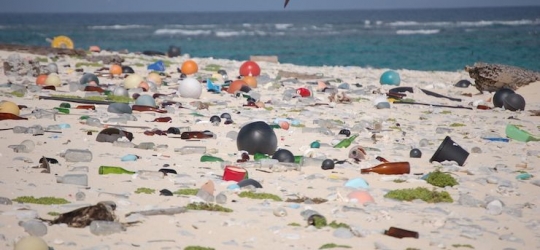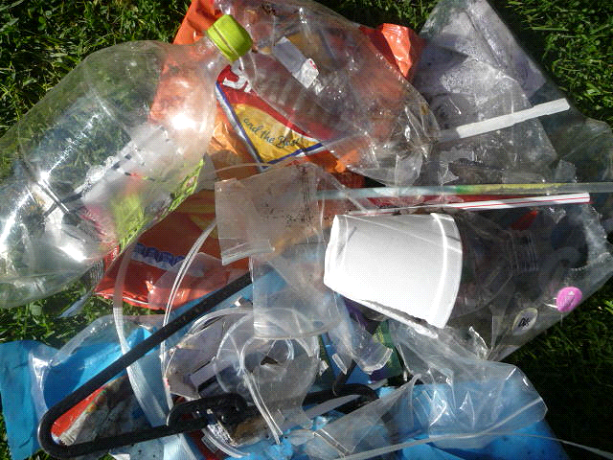
Study: Plastics a source of minuscule, but ‘climate-relevant,’ methane – USA
Posted on August 10, 2018 by DrRossH in Plastic Waste News
Marine debris that was washed ashore covers a beach on Laysan Island in the Hawaiian Islands National Wildlife Refuge. (Susan White/USFWS)
Plastics News
Researchers at the University of Hawaii found that most common plastics produce methane, a greenhouse gas, when exposed to sunlight. Among plastics tested, polyethylene — the largest volume plastic that finds use in applications ranging from packaging to toys — emitted the most methane.
“Plastic represents a source of climate-relevant trace gases that is expected to increase as more plastic is produced and accumulated in the environment,” said David Karl, senior author on the study and professor in UofH’s Manoa School of Ocean and Earth Science.
“This source is not yet budgeted for when assessing global methane and ethylene cycles, and may be significant.”
Researchers found that sunlight triggers the degradation of plastic, which results in emissions of methane. During a 212-day experiment, they tested the emission rate for low density PE in pellet form, in powder form and as debris collected from the ocean. They found that the rate of emission increased over the period of the study, and even occurred when LDPE was placed in a dark environment after being exposed to sunlight.
The results were unexpected but could be explained by researchers.
“We attribute the increased emission of greenhouse gases with time from the virgin pellets to photodegradation of the plastic, as well as the formation of a surface layer marked with fractures, micro-cracks and pits,” said lead study author Sarah-Jeanne Royer, a post-doctoral researcher with the Center for Microbial Oceanography: Research and Education at the time of the study. Surface degradation of plastic likely increases the methane emission rate.
The study results were published in the Aug. 1 edition of PLOS One, a peer-reviewed journal. The science team tested a range of plastics, including polycarbonate, acrylic, polypropylene, PET, polystyrene, high density PE and LDPE. All emitted methane to some degree under study conditions.
The amounts of methane emitted were minuscule. At the end of the 212-day period, LDPE’s emission rate was 92.8 millionths of a gram per kilogram of LDPE per day. Also emitted at comparable rates were ethylene, ethane and propylene.
Karl stated in an email that Sara Ferron, a postdoctoral researcher in his laboratory, made the initial discovery. The project was assigned to Royer when she joined Karl’s research team. Samuel Wilson, the other study author, is a world-leading authority on methane measurements who recently led a United Nations Scientific Committee on Ocean Research, which worked on an international intercomparison of analytical methods.
Plastic-emitted methane appears to be minuscule compared to other sources of methane like natural gas and biomatter decomposition, but it is not insignificant, Royer said. Plastic powder emitted 488 times more methane than plastic pellets. Much of the plastic discarded to the environment breaks down into small particles. Huge amounts of plastic litter are already present in the environment, and more is predicted.
“Everybody uses plastics, from cellphones to packaging,” Royer said in a phone interview. “One solution is to switch from single-use to reuse applications.”.
Royer said she approached major plastics companies but “they didn’t want to communicate with us.”
The study results are interesting but maybe not alarming, the study researchers indicate.
“Based on the rates measured in this study and the amount of plastic produced worldwide [methane] production by plastics is likely to be an insignificant component of the global [methane] budget,” the authors state.

 How many people today grab a takeaway coffee cup from the local cafe to drink on the go? We don’t know, but the number must be enormous.. Most every one of the above have a plastic top that will last 100s of years. Some cafes still use plastic cups that last a similar time. Is 10 minutes of coffee worth 100s of years of trash?
These items can be seen littering our gutters and on our streets all over the place. If they were all cardboard, they would still be littered, but they would, at least, be gone in a short time.
They do not need to be made of plastic.
How many people today grab a takeaway coffee cup from the local cafe to drink on the go? We don’t know, but the number must be enormous.. Most every one of the above have a plastic top that will last 100s of years. Some cafes still use plastic cups that last a similar time. Is 10 minutes of coffee worth 100s of years of trash?
These items can be seen littering our gutters and on our streets all over the place. If they were all cardboard, they would still be littered, but they would, at least, be gone in a short time.
They do not need to be made of plastic.
 On the way home from the gym last week, a distance of about 1 km (1/2 mile), I counted the items of plastic litter on the curb as I walked. In that short distance I counted 63 pieces of plastic litter. Plastic drink bottles, bottle tops, candy wrappers, plastic film, polystyrene fragments etc. That seemed to be a lot to me. I guess it is a generational thing. Our parents would have been horrified to see that amount, whereas it seems to go unnoticed by our youth of today. In another 20 years how many pieces will there be on this stretch, -- 200? What will today’s youth think of that new amount then when they are older? Will their children be so readily accepting of a higher amount of litter?
On the way home from the gym last week, a distance of about 1 km (1/2 mile), I counted the items of plastic litter on the curb as I walked. In that short distance I counted 63 pieces of plastic litter. Plastic drink bottles, bottle tops, candy wrappers, plastic film, polystyrene fragments etc. That seemed to be a lot to me. I guess it is a generational thing. Our parents would have been horrified to see that amount, whereas it seems to go unnoticed by our youth of today. In another 20 years how many pieces will there be on this stretch, -- 200? What will today’s youth think of that new amount then when they are older? Will their children be so readily accepting of a higher amount of litter?
Discussion · No Comments
There are no responses to "Study: Plastics a source of minuscule, but ‘climate-relevant,’ methane – USA". Comments are closed for this post.Oops! Sorry, comments are closed at this time. Please try again later.